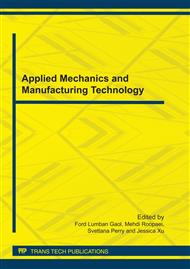[1]
Jin, Hai-yun, Wen Wang, Ji-qiang Gao, Guan-jun Qiao, and Zhi-hao Jin. Materials Letters 60., Study of machinable AlN/BN ceramic composites, 2006: 190-193.
DOI: 10.1016/j.matlet.2005.08.029
Google Scholar
[2]
Du, Xueli, Mingli Qin, Abdur Rauf, Zhihao Yuan, Baohe Yang, and Xuanhui Qu. Structure and properties of AlN ceramics prepared with spark plasma sintering. " Materials Science and Engineering A 496, 2008: 269-272.
DOI: 10.1016/j.msea.2008.05.027
Google Scholar
[3]
Katahira, K., H. Ohmori, Y. Uehara, and M. Azuma. ELID grinding characteristics and surface modifying effects of aluminum nitride (AlN) ceramic, International Journal of Machine Tools & Manufacture 45 2005: 891-896.
DOI: 10.1016/j.ijmachtools.2004.10.017
Google Scholar
[4]
Inasaki, Grinding of hard and brittle materials, Annals of CIRP 36 (2) 1987, 463–471.
DOI: 10.1016/s0007-8506(07)60748-3
Google Scholar
[5]
S. Malkin, T.W. Hwang, Grinding mechanisms for ceramics, Annals of CIRP 45 (2) 1996, 569–580.
DOI: 10.1016/s0007-8506(07)60511-3
Google Scholar
[6]
K. Li, W. Liao, Surface/subsurface damage and the fracture strength of ground ceramics, Journal of Materials Processing Technology 57, 1996, 207–220.
DOI: 10.1016/0924-0136(95)02090-x
Google Scholar
[7]
S. Jahanmir, H.H.K. Xu, L.K. Ives, Mechanisms of material removal in abrasive machining of ceramics, Machining of Ceramics and Composites, Marcel Dekker, New York, 1999, p.11–84.
Google Scholar
[8]
I. Marinescu, B. Rowe, L. Yin, H.G. Wobker, Abrasive processes, Handbook of Ceramics Grinding and Polishing, Noyes Publications, Park Ridge, New Jersey, 2000, p.94–189.
DOI: 10.1016/b978-081551424-4.50005-6
Google Scholar
[9]
Raj, R., Fundamental research in structural ceramics for service near 2000. J. Am. Ceram. Soc., 1993, 76, 2147–2174.
Google Scholar
[10]
I.P. Tursely, A. Jawaid, I.R. Pasbhy. Reciew: Various methods of machining advanced ceramics materials, Journal of materials processing technology, 42, 1994, 377-390.
DOI: 10.1016/0924-0136(94)90144-9
Google Scholar
[11]
J.E. Mayar Jr., G.P. Fang, Diamond grinding of silicon nitride, NIST S.P. 647, 1993, 205–222.
Google Scholar
[12]
J.E. Mayer Jr., G.P. Fang, Effect of grinding parameters on surface finish of ground ceramics, Annals of the CIRP 44 (1), 1995, 279–282.
DOI: 10.1016/s0007-8506(07)62325-7
Google Scholar
[13]
Takacs. M, Vero. B, Meszaros. I, Micro milling of metallic materials, Journal of Materials Processing Technology 138, 2003, 152-155.
Google Scholar
[14]
Rahaman. M, Senthil Kumar. A, Prakash J.R. S, Micro milling of pure Copper, Journal of Materials Processing Technology 116, 2001, 39-43.
DOI: 10.1016/s0924-0136(01)00848-2
Google Scholar
[15]
Sinan Filiz, Caroline. M Conely, Mathew. B Wasserman, O Burak Ozdoganlar, An experimental investigation of micro- machinability of Copper 101 using tungsten carbide micro-end mills, International Journal of Machine Tools and Manufacture 47(2007).
DOI: 10.1016/j.ijmachtools.2006.09.024
Google Scholar
[16]
Wang. W, Kweon.S. H, Yang.S. H, A study on roughness of Micro end milled surface produced by miniature machine tool, Journal of Processing Technology 162-163(2005) 702-708.
DOI: 10.1016/j.jmatprotec.2005.02.141
Google Scholar
[17]
Alauddin. M, EI Baradie.M. A, Hashmi M.S. J, Modelling of cutting force in end milling Inconel 718, Journal of Material Processing Technology 58(1996) 100-108.
DOI: 10.1016/0924-0136(95)02113-2
Google Scholar
[18]
Alauddin. M, EI Baradie.M. A, Hashmi M.S. J, Cutting forces in the end milling Inconel 718, Journal of Material Processing Technology 77(1998) 153-159.
DOI: 10.1016/s0924-0136(97)00412-3
Google Scholar
[19]
Abou- EI-Hossein.K. A, Kadirgama. K, Hamdi. M, Benyounis.K. Y, Prediction of cutting force in end milling operation of modified AISI P20 tool steel, Journal of Materials Processing Technology 182(2007) 241-247.
DOI: 10.1016/j.jmatprotec.2006.07.037
Google Scholar
[20]
Bao.W. Y, Tansel.I. N, Modeling micro end milling operations. Part 1: analytical cutting force model, International Journal of Machine tools & Manufacture 40(2000) 2155-2173.
DOI: 10.1016/s0890-6955(00)00054-7
Google Scholar
[21]
Chee Keong Ng, Shreyes Melkote. NW. Y, Rahman. M, Senthil Kumar, Experimental study of micro-and nano-scale cutting of aluminum 7075-T6, International Journal of Machine tools & Manufacture 46(2006) 929-936.
DOI: 10.1016/j.ijmachtools.2005.08.004
Google Scholar
[22]
Kang.I. S, Kim.J. S, Kim.J. H, Kang.M. C, Seo.Y. W, A mechanistic model of cutting force in the micro end milling process, Journal of Materials Processing Technology 187-188(2007) 250-255.
DOI: 10.1016/j.jmatprotec.2006.11.155
Google Scholar
[23]
Newby. G, Venkatachalam. S, Liang.S. Y, Empirical analysis of cutting force constants in micro-end-milling operations, Journal of Materials Processing Technology 192-193(2007) 41-47.
DOI: 10.1016/j.jmatprotec.2007.04.026
Google Scholar


